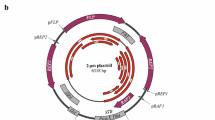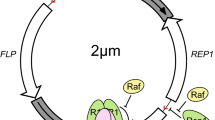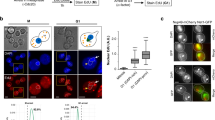Summary
The designation of the yeast 2 μ circle as a “selfish” DNA molecule has been confirmed by demonstrating that the plasmid is lost with exponential kinetics from haploid yeast populations grown in continuous culture. We show that plasmid-free yeast cells have a growth rate advantage of some 1.5%–3% over their plasmid-containing counterparts. This finding makes the ubiquity of this selfish DNA in yeast strains puzzling. Two other factors probably account for its survival. First, the rate of plasmid loss was reduced by allowing haploid populations to enter stationary phase periodically. Second, it was not possible to isolate a plasmid-free segregant from a diploid yeast strain. Competition experiments demonstrated that stability in a diploid is conferred at the level of segregation and that plasmid-free diploid cells are at a selective advantage compared with their plasmid-containing counterparts. Yeast cells in nature are usually homothallic and must frequently pass through both diploid and stationary phases. The 2 μ plasmid appears to have evolved a survival strategy which exploits these two features of its host's life cycle.
Similar content being viewed by others
References
Beggs JD (1978) Transformation of yeast by a replicating hybrid plasmid. Nature 275:104–109
Broach JR (1981) The Yeast Plasmid 2 μ Circle. In: Strathern JN, Jones EW, Broach JR (eds) The molecular biology of the yeast Saccharomyces: Life cycle and inheritance. Cold Spring Harbor Laboratory, Cold Spring Harbor, NY pp 445–470
Brown SW, Sugden DA, Oliver SG (1984) Ethanol production and tolerance in grande and petite yeasts. J Chem Technol Biotechnol 34B:116–120
Dawkins R (1976) The selfish gene. University Press, Oxford
Doolittle WF, Sapienza C (1980) Selfish Genes, the phenotype paradigm and genome evolution. Nature 284:601–603
Erhart E, Hollenberg CP (1983) The presence of a defective LEU2 gene on 2 μ DNA recombinant plasmids of Saccharomyces cerevisiae is responsible for curing and high copy number. J Bacteriol 156:625–635
Futcher AB (1986) Copy number amplification of the 2 μ circle plasmid of Saccharomyces cervisiae. J Theor Biol 119:197–204
Futcher AB, Cox BS (1983) Maintenance of the 2 μ circle plasmid in populations of Saccharomyces cerevisiae. J Bacteriol 154:283–290
Hartley JL, Donelson JE (1980) Nucleotide sequence of the yeast plasmid. Nature 286:860–864
Jayaram M, Li Y-Y, Broach JR (1983) The yeast plasmid 2 μ circle encodes components required for its high copy propagation. Cell 34:95–104
Jayaram M, Sutton A, Broach JR (1985) Properties of REP3: a cis-acting locus required for stable propagation of the Saccharomyces cerevisiae plasmid 2 μ circle. Mol Cell Biol 5:2466–2475
Kikuchi Y (1983) Yeast plasmid requires a cis-acting locus and two plasmid proteins for its stable maintenance. Cell 35:487–493
Moser H (1958) The dynamics of bacterial populations maintained in the chemostat Carnegie Institute of Washington Publication 614
Murray AW, Szostak JW (1983) Pedigree analysis of plasmid segregation in yeast. Cell 34:961–970
Orgel LE, Crick FHC (1980) Selfish DNA: The ultimate parasite. Nature 284:604–607
Rigby PWJ, Dieckmann M, Rhodes C, Berg P (1977) Labelling deoxyribonucleic acid to high specific activity in vitro by nick translation with DNA polymerase I. J Mol Biol 113:237–251
Sherman F, Fink GR, Hicks JB (1983) Methods in yeast genetics. A laboratory manual. Cold Spring Harbor Laboratory, Cold Spring Harbor, NY
Sherratt D (1986) Control of plasmid maintenance. In: Booth JR, Higgins CF (eds) Regulation of gene expression — 25 years on. University Press, Cambridge, U.K. pp 239–250
Sigurdson DC, Gaarder ME, Livingston DM (1981) Characterisation of the transmission during cytoductant formation of the 2 μ DNA plasmid Saccharomyces. Mol Gen Genet 183:59–65
Siliciano PG, Tatchell K (1984) Transcription and regulatory signals at the mating-type locus in yeast. Cell 37:969–978
Southern EM (1975) Detection of specific sequences among DNA fragments separated by gel electrophoresis. J Mol Biol 98:503–517
Toh-E A, Guerry P, Wickner RB (1980) A stable plasmid carrying the yeast LEU2 gene and containing only yeast deoxyribonucleic acid. J Bacteriol 141:413–416
Walmsley RM, Gardner DCJ, Oliver SG (1983) Stability of a cloned gene in yeast grown in chemostat culture. Mol Gen Genet 192:361–365
Author information
Authors and Affiliations
Additional information
Communicated by B.J. Kilbey
Rights and permissions
About this article
Cite this article
Mead, D.J., Gardner, D.C.J. & Oliver, S.G. The yeast 2 μ plasmid: strategies for the survival of a selfish DNA. Mol Gen Genet 205, 417–421 (1986). https://doi.org/10.1007/BF00338076
Received:
Issue Date:
DOI: https://doi.org/10.1007/BF00338076




